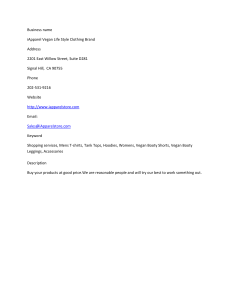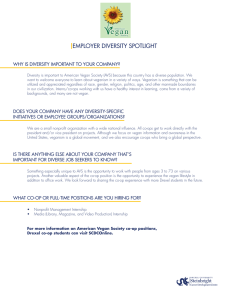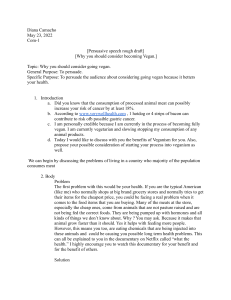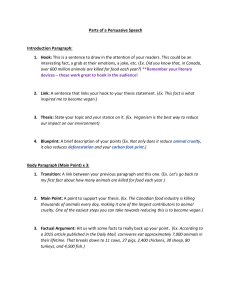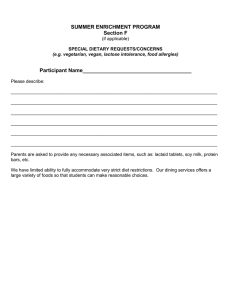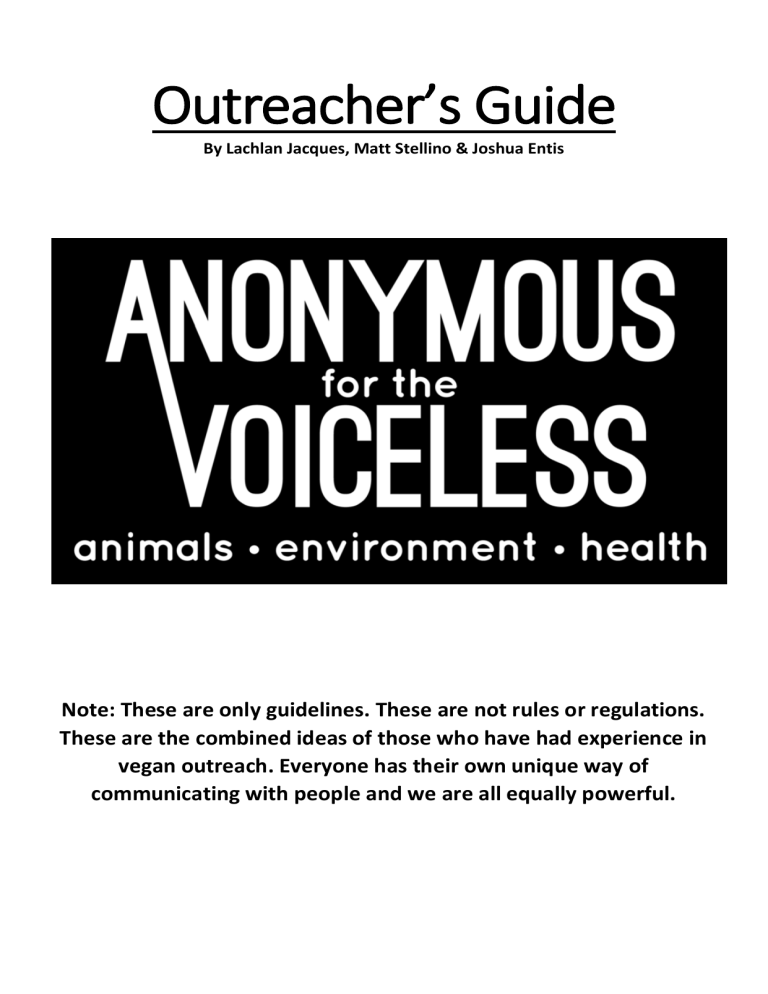
Outreacher’s Guide By Lachlan Jacques, Matt Stellino & Joshua Entis Note: These are only guidelines. These are not rules or regulations. These are the combined ideas of those who have had experience in vegan outreach. Everyone has their own unique way of communicating with people and we are all equally powerful. How to approach people, DO’s and DON’Ts People are sensitive and will respond to the energy that you give them. If your presence makes them feel good then they will be more inclined to listen and less inclined to argue. If your presence makes them feel tense and you are talking at them instead of talking with them the opposite will happen. DO: Be friendly SMILE – Smiling is important in gaining people’s trust! Listen to them when they speak Be non-argumentative Be clear Be assertive (not aggressive) Be prepared for lots of questions and objections Be understanding of where they are at DON’T: Be aggressive Chase people Be argumentative Raise your voice Blame people Interrupt people Laugh at their questions Get frustrated with their objections and questions (we were all nonvegans once in our life) The 5 Pillars of Outreach Ask / Listen / Understand / Educate / Inspire: Ask open ended questions (get people to talk): "Are you aware of what happens in the dairy industry?" instead of "This is what happens in the dairy industry" Actively listen and use the information people give you about them. Everything they tell you is important. People like to be listened to, understood, it creates a lot of trust. If someone tells you that they are huge environmentalists you might say towards the end of the conversation ‘I remember you told me you were really concerned about the environment, there’s a documentary called Cowspiracy and I think you more than all people would love it.’ Also listen to non-verbal gestures, if someone’s nonverbals are becoming defensive you might want to take your foot off the accelerator for a while. Understand that we were in their shoes so that people don't feel judged. Be compassionate. Empathise. Understand that they are a victim of conditioning. "I totally understand where you coming from, I remember I used to say that." Educate during the conversation find ways to strategically give information, to fill the gap of what they already know. If you don't know something it's ok; say that it is not something you're focusing on, and find someone who knows and may give more information. Learn afterwards. Inspire them to go vegan. Empower them. Say "how can I help you?", "how can I make things easier for you?" Different people will need different inspiration. Someone’s inspiration might be challenge22, someone elses might be to do more research or to go to a vegan restaurant that night (if they’re looking for a place to eat). Find a course of action that you believe they will take based on your conversation and encourage them to do it. When doing this though it’s important not to encourage people to ‘go vegan one day a week’ or anything that discredits veganism as a matter of justice. RED LIGHT Topics to avoid discussing, encouraging and advocating. Vegetarianism: Vegetarianism involves the torture, death and exploitation of animals and isn’t something to advocate. When you do come into conversation with a vegetarian instead of giving them a high-five ask them why they chose to become vegetarian. They will more than likely say that it is because of animal reasons and they have a genuine moral concern for animals. This will open an opportunity to discuss how veganism is the only solution to having moral concern for animals. You can pose questions such as: ‘Are you aware of what happens to cows and chickens in the dairy and egg industry?’ Explain the process of dairying. i.e. artificial insemination, baby stealing, repeated milking, slaughter etc. Explain the process of the egg industry i.e. debeaking, male chicks being shredded or blended, stress on the chicken’s bodies etc. Vegetarians often believe they are doing the right thing by animals. You can use this as an opportunity to explain to them that their intentions are good but they’re actions are still causing suffering and death as there is no moral distinction between meat, dairy, eggs, leather, wool etc. Baby steps: Baby steps are for babies. As animal advocates, we shouldn’t be encouraging people to stop exploiting animals gradually. If someone decides that they will go vegan but they will transition over a period that is their decision however it’s not always a good thing to encourage. Our job is to clearly communicate that veganism is a starting point or the very least we could do. People often have an idea that veganism is something that will be very challenging. As vegan advocates it is important that we can discuss how easy and delicious it is! Philosophical hypotheticals: Often people will come up with crazy hypothetical scenarios that if they ‘were stranded on a desert island and there was no vegetation blah blah blah’… Don’t entertain them too much. Try and bring the conversation back to reality. YELLOW LIGHT Topics to talk a little bit about but not to focus the whole conversation on. Health: Some people are convinced they need animal products to be healthy. It’s important that we can answer basic nutritional questions such as: ‘What about protein?’ ‘What about calcium?’ ‘How will I get enough calories?’ ‘B12 though?’ ‘Do you need supplements?’ etc. Depending on how long you are talking to someone, the health aspect of veganism can be something good to mention however don’t make this the centre of your conversation otherwise you’ll lose track of talking about the animals. Point out that not only can we survive and be healthy as vegans but we are much healthier without eating any animal products. Example: If you are not knowledgeable in the field nutrition and health don’t stress, just make sure you can answer some basic questions. However, spend some time researching this topic. When we are talking to nonvegans and display an in depth understanding about health the non-vegan will very quickly subside any doubts they have about whether it is healthy or not to be vegan. Point out that many professional athletes have switched to a vegan diet to help improve their performance. Memorise maybe one or two of them. Environment: Many people are becoming aware of the environmental impacts of raising and killing animals for food and they may even bring this topic up themselves. Again, there is no need to have an in depth understanding of this topic but we need to be able to answer basic questions and objections such as: ‘Well what about sustainability, we don’t have enough land to feed everyone a vegan diet.’ ‘I read an article that said a vegan diet caused more harm to wildlife than an omnivorous one.’ We can point out a few things to people without overcomplicating the situation and without it dominating the conversation. Memorise a few facts. The conversation will rarely steer into the subject of sustainability but if it does, let it go there for a while but then bring it back to the animals. Here are a few facts that are worth memorising that will generally put people’s objections to bed: ‘You can grow 15x more plant protein on any given acre of land than animal protein. That’s because it takes much more land, water and food to raise and kill an animal as opposed to just eating fruits and vegetables directly from the ground.’ ‘We currently grow enough food to feed 10 billion people, instead we feed 50% of the grain to the animals we use for food.’ Do some research in this area. There’s no need to be a sustainability guru. Just know some basic facts and use them when they are needed. This is not always the best topic to base your conversation around but it will help paint a larger picture for some people. Treatment of animals: Wait. Hold on. Why isn’t this section in the green light? Shouldn’t this dominate our conversation? I thought we were animal advocates? What is left to talk about? Good question. When we revolve our conversation around the treatment of animals we may run the risk of engaging in the idea that is already prevalent among society; that we can justify using animals if we treat them well. So, if we have a 5-minute conversation with someone and we spend 4 and a half minutes talking about how animals are treated on farms then we haven’t been clear that these animals shouldn’t be on the farms in the first place. The primary problem is not how we treat animals the problem is that we are using them as resources and that they are someone’s property, this is what we should communicate. It’s good sometimes to talk about how the industries operate. Explaining what happens to these animals while they are alive can be powerful. If someone asks about dairy, describe the dairy industry. If someone asks about eggs describe the egg industry. However, be crystal clear that it doesn’t matter if they have the horrible lives that they do now, or if they have the best lives possible, if we kill them then we have done something incredibly morally unjustifiable. So, understand how the industries operate but don’t spend all your time talking about it. Thanks to animal welfare reforms people are convinced in ‘humane’ killing. Our biggest and most imperative challenge is to dispel this nonsense. GREEN LIGHT GO! GO! GO! What to centre your conversation around. Use of animals and veganism as a moral baseline: 99% of people agree that animals are not things. They all agree on this because they can recognise that an animal is someone and not something, to what capacity an individual may care about animals varies from person to person. Nonetheless, almost every person you speak to will agree with you that animals are not things and that they have interests. They will also agree with you that it is wrong to inflict unnecessary suffering and death on an animal. In fact, a lot of people will be repulsed by this idea. So, let us be clear about this. If animals are not things, then we should not use them as resources ESPECIALLY when we have no reason to do so. This is a lot easier than you might think. Everyone agrees that human slavery is wrong. Why? Because people should not own other people. Same thing with animals. If we can recognise that they are someones and not somethings, then we cannot own them. The moment you are property and the moment someone owns you, the only value you have is the value that someone else gives to you. Animals used for food have no value other than the value we accord to them which is economic value. We must communicate veganism as a matter of fundamental justice and not a diet, lifestyle, journey, personal choice or a way of reducing suffering. If we promote veganism as anything else other than a matter of fundamental justice people will not take it seriously enough to create a movement. So, if 99% of everyone you speak to agrees that it is wrong to inflict unnecessary suffering and death on an animal, explain to them how they are engaging in violence towards animals with their food choices. Explain why it is unnecessary and why it is going against THEIR own belief. If those same people recognise that animals are not commodities. Explain to them why we shouldn’t be treating them as things and USING them as resources. Finally explain why veganism is the ONLY rational, logical and sane solution to recognising that we shouldn’t be hurting and killing animals unnecessarily and recognising that they are sentient beings. Explain why if they aren’t vegan then they are engaging in animal exploitation. This doesn’t mean be aggressive or accusatory. It simply means being clear. Ask them if this makes sense. You will get a clear indication of where they are at when you ask them, ‘does that make sense?’. If the answer is yes, reinforce it. If the answer is no, keep trying until either you can see you won’t get through to them or they walk away. People are willing to learn and listen. So, let us be clear. We must recognise animals as persons. Once we recognise that they are persons then it isn’t a question of encouraging people to ‘take little steps’. It’s a matter of the most basic and fundamental right of all living beings. The right not to be used or treated as property. Make this the focal point of your conversation. Veganism should never be about us or our own personal journey. If someone wants to talk about health, talk about health. If someone wants to talk about the environment talk about the environment. However, make this the main point that you want to communicate and offer the health and environmental benefits as something that will come along with going vegan. Use words like ‘justice’, ‘injustice’ and ‘fairness’ instead of words and phrases like ‘reducing suffering’ and ‘kindness’. For example; If you’re walking down the street and you see a dog and you choose not to kick the dog in the head that isn’t an act kindess. It’s just basic fairness. Another example: A slave owner who decides that owning human slaves is morally wrong and decides to set them free. This isn’t an act of kindness. It’s just basic morality. When someone suggests baby steps or long spiritual journeys where they finally go vegan at the age of 67 on top of a Himalayan mountain, don’t let them off the hook so easily. Veganism is the very least that animals deserve and speak up for animals the way you would want to be spoken for if it was you in their position. When someone asks, ‘how can I help?’ tell them they must start by going vegan. Veganism is only the starting point here. An individual cannot help animals whilst they pay people to kill them. If you keep this in mind constantly then your message will be the same to everyone you speak to. Whether they are 8 years old or 80 years old it’s the same; GO VEGAN. Personalise the animals story It’s much more powerful to speak about animals as if they were individuals. When we are explaining what happens to animals if we personalise their story people will naturally feel more emotion for the story of an individual rather than a group of billions. For example, when we are explaining the dairy industry. Tell the story of one dairy cow rather than the entire industry; ‘In the dairy industry a cow will be forcibly impregnated, against her will, by a farmer who has a hand full of bull semen. After a 9-month pregnancy she will give birth and being such a maternal animal, this is the most significant moment in her life…. Etc.’ Is better than; ‘In the dairy industry cows will be forcibly impregnated, against their will, by a farmer who has a hand full of bull semen. After a 9-month pregnancy they will give birth and being such maternal animals, this is the most significant moment in their life…. Etc.’ The facts are still the same but we’ve changed the story from a group of billions to one individual. It makes the situation more personal for the non-vegan receiving the information. Charities are aware of this which is why they always tell the story of an individual to receive donations rather than talking about millions of people. Connecting with people Ultimately, one of the most important (if not THE most important) aspects of talking to people is your ability to connect with them on a personal level. Therefore, it’s so important that a wide variety of people from different social status, ethnicity, age, gender, religion etc. speak out about veganism. You’re not going to be able to connect with everyone on an intimate level. It’s impossible. But there are a few things that you can do to maximise your chance someone remembering you and your conversation. 1. “I used to be in exactly the same boat” Think back to when you were a non-vegan. You had a lot of the same excuses that people have today whether they were subconscious or conscious. When someone proposes an objection, isn’t engaging, has their arms folded or even if they ARE opening up, saying something as simple as “I used to feel the same, but what I found was...” will make people’s eyes will light up. When people feel understood and feel as if their position is not trivialised then they will be more likely to change their position. When someone’s worldview is challenged a part of the brain which is used for sensing fear or danger is activated which is why people can be so defensive and often say stupid things like ‘I would eat my dog if I had to survive’ to save face. If the other person identifies you as a threat then they will backfire but if they identify you as someone who understands them and used to be in the same position as then they will be like putty in your hands. 2. Encouragement Encourage people that they can go vegan; “You can do it, it’s so easy!”, “You’re on the right track keep researching!”. Encouraging someone is always better than putting someone down for not being vegan. Be careful with this one though. Don’t encourage someone you think is being airy fairy about veganism who says something like “I’ll get there one day.” With someone like that it might be best to discuss veganism as a matter of justice for some time. However, there are many people who are genuinely interested in becoming vegan and who are seeking information to help them make the connection and encouraging these sorts of people is a very effective form of activism. 3. Personal story Share your story. It might seem uninteresting to you but you can make it sound interesting and inspiring if you tell the story with conviction and passion. ‘I used to eat meat every day and I never really even thought about it. I’ve always lived with animals and always considered myself someone who care about animals and it wasn’t until someone pointed it out to me that I saw I was living in a contradiction. With one hand I would pat my dog and with the other hand I was eating a dead animal. So, 2 years ago I went vegan and I feel so much better for it!’ People forget facts and remember stories. 4. Being aware of the person you are talking to. You will obviously talk differently to a 16-year-old boy than you would to a 40 year old woman. If you’re a man talking to a younger man you can say things such as ‘do you know what I mean dude/bro/man?’ to make them feel like they are talking with an equal. If you’re talking to an older woman you might talk about the dairy industry and the calf separation as they might relate to that being a mother themselves. There’s no roadmap for this but just be aware of who you’re talking to and what they might be sensitive to. 5. Use words like ‘we’ and ‘us’ instead of ‘you’ and ‘me’. At the end of the day we are in this together. We’re on the same planet. We’ve been fed the same lies. We’re of the same species. See everyone as a potential friend instead of a potential enemy. Think about how grateful you are for the activists you educated you and helped you make the connection. Example: ‘You’ve been lied to. You’ve been told that a dog’s life matters more than a cow’s. You’ve been told you need protein from animal flesh.’ Here’s the same sentence again but instead of ‘you’ it’s ‘we’. ‘We’ve been lied to. We’ve been told that a dog’s life matters more than a cow’s. We’ve been told we need protein from animal flesh.’ What a huge difference between the two sentences. The first sentence people are likely to feel like they’re being lectured. The second is a sharing of information from one human to another. 6. Speak from the heart. Don’t be afraid to pour your heart out to someone. Logical arguments are of course in our favour but what’s even more powerful is winning someone’s heart with a heartfelt conversation. Think of the most effective vegan activists. There are two that come to mind straight away; Gary Yourofsky and James Aspey. They get on stage, make themselves vulnerable and pour their heart out. And it works. You don’t have to be Gary or James to do this. Anyone can do it. In saying this, if someone is a logical analytical person then keep it logic based. However, if someone is having an emotional reaction to the video then don’t discuss logical arguments. Keep it an emotionally driven conversation. 7. ‘Good question’ Where do you get your protein is the best question you’ve ever heard and it’s the first time you’ve heard it. Treat every question as a good one and be excited to answer it. Validate their questions as good ones, they’ll be likely to ask more of them. Socratic Questioning Socratic questioning is a simple technique which will get the other person to think and have to rationalise an answer for themselves rather than have to listen to your answer. When you ask someone a question, often people may be more likely to engage in the conversation opposed to telling them information. Here are some examples of how you can turn a general statement into a form of question: ‘There is no way humane way to kill an animal who doesn’t want to die’ ‘Do you think there is a humane way to kill an animal who doesn’t want to die?’ ‘You don’t need animal products to be healthy.’ ‘Do you think you need animal products to be healthy?’ ‘If there is no necessity to use animals for food then we can’t justify doing it.’ ‘If there is no necessity to use animals for food do you think we can justify continuing to do it?’ ‘You can get all the nutrients in the world from plants.’ ‘Do you think there are any nutrients that you can’t get from plants?’ Such a simple change in the delivery of the message can have such a profound effect on how the message is being received. Asking questions is the least intrusive way of communication. You’re just asking for their opinion, you don’t have to give yours. Then, as people give their answer they can see any inconsistencies in their response. Even if you don’t get the response you were hoping for it doesn’t matter, respond with a question wherever possible. The goal of using the Socratic method is not to disprove the other party so that you can dance around and proclaim your superiority. It is used to highlight to themselves any limitations, contradictions or assumptions in their belief system and in doing so prime them to be ready to receive new information. It is extremely important to remain humble and friendly while using the Socratic method. If you present as taking glee in the person’s confusion it is unlikely they will wish to continue talking to you. ‘The Staircase’ is a simple idea. It’s a series of steps to take in order to sell a product, service, or in the case of Veganism, an idea. Broken down it is as follows: Rapport is an essential element for building trust & having someone be willing to open up to you and tell you what they truly think. Without knowing what someone thinks or feels, you will not be able to uncover the Need. Once you have uncovered the need, you have given the person a reason to seek out a Solution. Offering a solution for where there is no Need is largely pointless. Once the solution has been presented you want to take the person from browsing to buying it & this is done through the Close. Each step must be taken & it is critical that no step be missed or when you attempt to place your feet on the step beyond it you will find the staircase has become unstable & will be at risk of collapsing. An example of using the staircase at the cube would be: Rapport: Approach someone with a smile, ask how their day is going & if they have ever seen anything like this before. If they make mention that the footage is disturbing or hard to view than illustrate sameness by agreeing & stating that you too find it to be terrible to see. Need: Work out through probing questions where the individual need for veganism sits with the person you are speaking with. It may be that they care deeply about animals, the environment or for their own health. Once you have found the trigger point(s) you must really work them. Solution: Veganism aligned with their trigger points. Close: Ask them directly if they will try the 22 Day Vegan challenge or if they are ready to remove animal products from their life so that their actions fit with their ethics. The close is there to give them an actionable next step & ensure they don’t remain a ‘Window Shopper’. Feel, Felt, Found is the most effective framework for handling objections & overcoming a difference of opinion as it starts with empathy & ends with experience. Feel: I understand how you feel.. (Don’t just state it, really MEAN it!) Empathy removes barriers and makes them feel as though you are not simply dismissing their objection without consideration. Felt: I (or others) felt the exact same way.. Showing that you once shared their position or opinion helps to build harmony and rapport. The other thing it does it shows that their objection isn’t unique & opens them up to learning what solutions were discovered by someone else in the same situation. Found: What I (or others) found was.. Share with the person what others discovered that led them to change their view. This offers social proof & allows them to see that the path ahead has been walked by others and is much more likely to be considered as a suitable path for them. Cube Example: Statement: It would be really difficult to be a Vegan.. F,F,F Response: I can completely understand that you would feel that to be true. In fact, I once felt as though being Vegan would be the most restrictive thing in the world! What I & a lot of my vegan friends have since found though is that it is remarkably easy. Vegan options are available almost anywhere and becoming Vegan has opened up a whole new world of delicious food. Body Language; It’s in the Palm of Your Hands. According to a study conducted on body language and audience compliance, the same instructions were given to 3 separate audiences with each audience having a separate sets of hand gestures; finger pointing, palms facing down, palms facing up. 28% of the audience complied with the instructions. 52% of the audience complied with the instructions. 84% of the audience complied with the instructions. If someone starts finger pointing, they may not point their finger directly at you but they might be using their finger to point while they’re talking, subconsciously it feels like we are being spoken down to whilst being given orders. When the palms are facing down and someone is asking us to do something it we feel like we have still been given orders by an authoritarian figure. When the palms are facing up however and we are asked to do something, we may feel as if this person is our friend and we are doing our friend a favour. Body language is the outward reflection of your emotion and it makes up for more than 50% of your communication. If you’re feeling tense or angry it will reflect through your body language, particularly your hand gestures. However, the good news is body language also effects emotion! So, if you are feeling tense or frustrated, notice what you’re hand gestures are doing, see if you can face your palms up and you might start feeling like you’re calming down. Try and make a conscious effort to observe your hand gestures when speaking to people about veganism. See if you can keep your palms facing upwards for most of the conversation when you are using hand gestures. Of course, don’t get carried away and start making unnatural hand gestures. Just hand gestures you would normally do. Do them as you would but with the palms facing up. Studies have shown that this is the best way to get people on your side! Copy and paste this into YouTube and watch this 15 minute TED Talk on this topic: Body language, the power is in the palm of your hands | Allan Pease | TEDxMacquarieUniversity Other important body language includes smiling and raising of the eyebrows. Even if it seems inauthentic we are hard-wired to see a potential friend when someone smiles and raises their eyebrows. Golden Questions Do you think we need to eat animal products to be healthy? This will uncover whether the person understands that killing animals is unnecessary. If they think it’s still necessary to kill animals for food they are much less likely to understand the ethical argument so you can use this question to navigate. Once they understand, or at least begin to understand that it’s unnecessary then the ethical argument is very easy to communicate. What does your heart tell you? By far and away the most powerful question you can ask someone. If they are having an intellectual debate with themselves or trying to justify their position, put one hand on your heart and the other on their shoulder and say, ‘I understand what you’re saying, but what does your heart tell you when you see these videos?’ You’ll see their guard drop, even if it’s for a split second. People will almost always give you an honest answer with this question especially if you ask it with heartfelt sincerity. Do you think there’s a difference between eating dogs and eating other animals like cows and chickens? People are disgusted by the idea of eating dogs. This question will help draw a comparison that they might never thought about. Most people will be honest and say ‘no’. They will almost certainly feel like a hypocrite after answering this question so it might be good to follow up with something like ‘it’s crazy because I used to think the idea of eating dogs was disgusting whilst I would eat cows, then I realised, if I wouldn’t eat a dog I shouldn’t be eating any animal.’ Then you’ve made it about your journey which they can relate to. Conversation example This is just a short extract from a conversation that involves Socratic questioning as well as some of the techniques discussed to connect with people… ‘What do you think of trophy hunting?’ ‘I think it’s horrible that people kill animals just for fun.’ ‘Me too. Everybody hates trophy hunting and activities that kill animals for no reason. Do you think we can justify using animals for food any more than a trophy hunter can justify using animals for entertainment?’ ‘Yes, because we are doing it to survive.’ ‘You don’t think that we can survive without eating animals?’ ‘I guess we don’t NEED to eat meat, but I don’t know...’ ‘I was in the same position as you 2 years ago. I live with a dog and I’ve always cared about animals and always tried to care for him but then I found myself in a contradiction as with one hand I would pat my dog and with the other I would stick a dead animal in my oven.’ ‘But what about protein? ‘Good question. All the nutrients in the world that we need, including protein, exist in plants. All of the biggest, strongest land mammals like elephants and gorillas are herbivores…’ There are many ways and many different questions which will lead people to the conclusion that veganism is the answer. Experiment with different ways. See what works for you and what doesn’t. Educate yourself. Make sure you’re able to answer all the questions. You don’t have to be a scholar you but you must be more educated on this topic than the person you’re speaking to. Enjoy your outreach. Don’t put too much pressure on yourself. We are not aiming to make everybody vegan on the spot. So, be cool, be calm and be clear.
